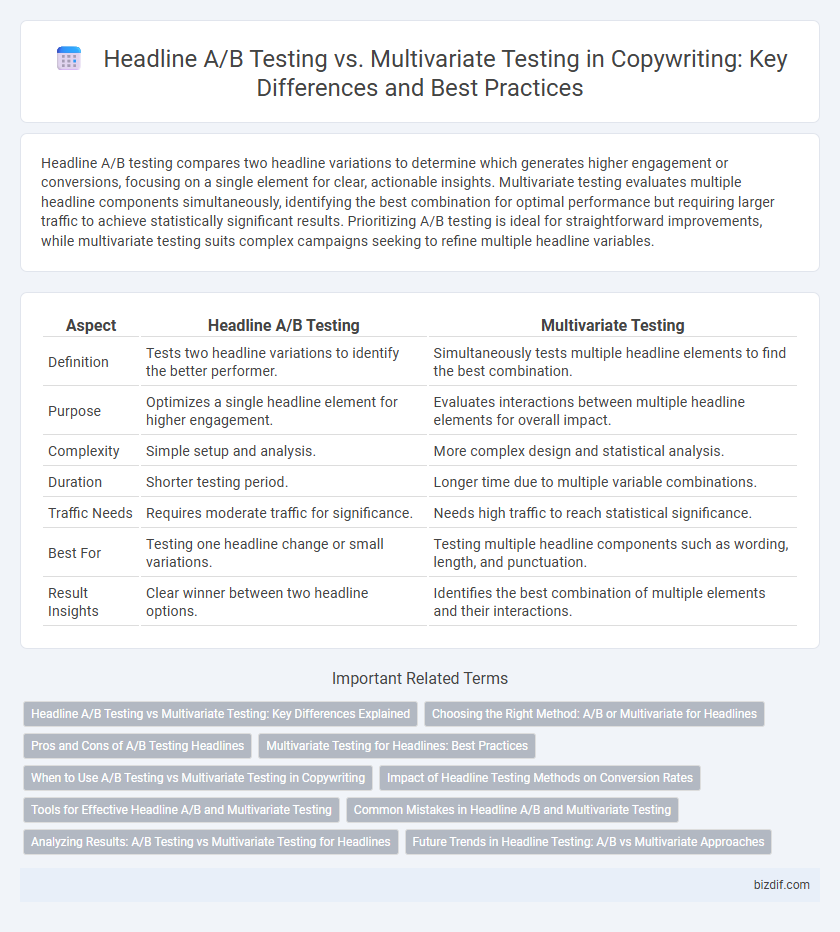Headline A/B testing compares two headline variations to determine which generates higher engagement or conversions, focusing on a single element for clear, actionable insights. Multivariate testing evaluates multiple headline components simultaneously, identifying the best combination for optimal performance but requiring larger traffic to achieve statistically significant results. Prioritizing A/B testing is ideal for straightforward improvements, while multivariate testing suits complex campaigns seeking to refine multiple headline variables.
Table of Comparison
| Aspect | Headline A/B Testing | Multivariate Testing |
|---|---|---|
| Definition | Tests two headline variations to identify the better performer. | Simultaneously tests multiple headline elements to find the best combination. |
| Purpose | Optimizes a single headline element for higher engagement. | Evaluates interactions between multiple headline elements for overall impact. |
| Complexity | Simple setup and analysis. | More complex design and statistical analysis. |
| Duration | Shorter testing period. | Longer time due to multiple variable combinations. |
| Traffic Needs | Requires moderate traffic for significance. | Needs high traffic to reach statistical significance. |
| Best For | Testing one headline change or small variations. | Testing multiple headline components such as wording, length, and punctuation. |
| Result Insights | Clear winner between two headline options. | Identifies the best combination of multiple elements and their interactions. |
Headline A/B Testing vs Multivariate Testing: Key Differences Explained
Headline A/B testing compares two headline variations to identify which single element drives higher engagement, focusing on simplicity and clear cause-effect results. Multivariate testing evaluates multiple headline elements simultaneously, uncovering interactions between variables but requiring larger sample sizes and complex analysis. Understanding the key differences in scope, complexity, and data interpretation helps optimize headline performance strategically.
Choosing the Right Method: A/B or Multivariate for Headlines
Selecting the right headline testing method depends on your campaign goals and resource availability; A/B testing suits testing two headline variations to identify a clear winner, while multivariate testing evaluates multiple headline elements simultaneously for optimized combinations. A/B testing provides straightforward insights with lower complexity, ideal for beginners or limited traffic sites, whereas multivariate testing requires larger sample sizes and advanced analytics to measure the impact of headline components on user engagement. Balancing test duration, audience size, and the need for precise data drives effective decision-making between A/B and multivariate headline testing strategies.
Pros and Cons of A/B Testing Headlines
A/B testing headlines allows precise comparison between two variants, making it easier to identify which headline drives higher click-through rates, but it limits insights to only one element at a time. This method is cost-effective and straightforward, enabling quick decision-making for marketers with tight deadlines. However, A/B testing cannot reveal complex interactions between multiple headline components, potentially overlooking combinations that optimize engagement.
Multivariate Testing for Headlines: Best Practices
Focus on using multivariate testing for headlines by simultaneously testing multiple headline elements such as wording, length, and tone to identify the most effective combination. Prioritize significant sample sizes and statistically valid results to ensure reliable data-driven decisions. Maintain consistent tracking and analysis to optimize headline performance and maximize conversion rates.
When to Use A/B Testing vs Multivariate Testing in Copywriting
A/B testing is ideal for comparing two distinct headline variations to identify which resonates better with the target audience, especially when testing straightforward changes in copywriting. Multivariate testing suits complex scenarios where multiple headline elements such as wording, tone, and length are simultaneously adjusted to determine the most effective combination. Selecting A/B testing or multivariate testing depends on the number of variables and the depth of insight required for optimizing headline performance.
Impact of Headline Testing Methods on Conversion Rates
Headline A/B testing isolates two distinct headline variations to identify which drives higher conversion rates by focusing on singular change elements. Multivariate testing evaluates combinations of multiple headline components simultaneously, revealing optimal interactions that maximize user engagement and conversion. Utilizing these headline testing methods strategically enhances conversion rates by providing data-driven insights into audience preferences and behavior.
Tools for Effective Headline A/B and Multivariate Testing
Top tools for effective headline A/B and multivariate testing include Google Optimize, Optimizely, and VWO, which offer robust features for splitting traffic and analyzing performance metrics. These platforms enable marketers to test multiple headline variations simultaneously, providing data-driven insights to optimize click-through rates and engagement. Seamless integration with analytics and content management systems improves test accuracy and speeds up decision-making processes.
Common Mistakes in Headline A/B and Multivariate Testing
Common mistakes in headline A/B testing include testing multiple variables simultaneously, which skews results, and relying on too small a sample size, leading to inaccurate conclusions. In multivariate testing, a frequent error is overcomplicating the test with too many variables, causing analysis paralysis and extended testing periods. Both methods often suffer from ignoring audience segmentation, resulting in misleading insights that fail to improve overall campaign performance.
Analyzing Results: A/B Testing vs Multivariate Testing for Headlines
Analyzing results in headline testing involves understanding the distinction between A/B testing and multivariate testing methodologies. A/B testing compares two distinct headline variations, providing clear, statistically significant data on which headline drives higher engagement or conversion rates. Multivariate testing examines multiple headline elements simultaneously, revealing interaction effects and the best combination of headline components for optimizing user response.
Future Trends in Headline Testing: A/B vs Multivariate Approaches
Future trends in headline testing emphasize the integration of AI-driven algorithms to enhance both A/B and multivariate testing accuracy, enabling marketers to predict audience engagement more precisely. Multivariate testing is evolving to handle complex variable interactions at scale, while A/B testing remains vital for quick validation of distinct headline concepts. Emerging tools prioritize real-time data analytics and adaptive learning models to optimize headline performance across diverse platforms.
Headline A/B Testing vs Multivariate Testing Infographic

 bizdif.com
bizdif.com